Profiles (photutils.profiles)¶
Introduction¶
photutils.profiles provides tools to calculate radial profiles and
curves of growth using concentric circular apertures.
Preliminaries¶
Let’s start by making a synthetic image of a single source. Note that there is no background in this image. One should background-subtract the data before creating a radial profile or curve of growth.
>>> import numpy as np
>>> from astropy.modeling.models import Gaussian2D
>>> from photutils.datasets import make_noise_image
>>> gmodel = Gaussian2D(42.1, 47.8, 52.4, 4.7, 4.7, 0)
>>> yy, xx = np.mgrid[0:100, 0:100]
>>> data = gmodel(xx, yy)
>>> error = make_noise_image(data.shape, mean=0., stddev=2.4, seed=123)
>>> data += error
(Source code, png, hires.png, pdf, svg)
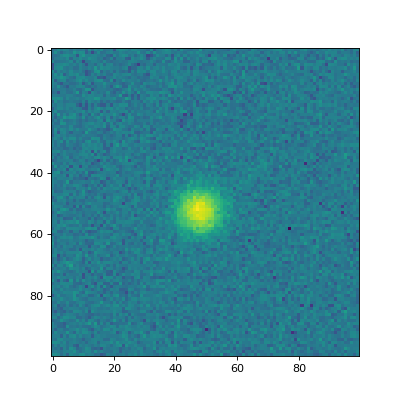
Creating a Radial Profile¶
Photutils provides the RadialProfile class
for computing radial profiles. The radial bins are defined by inputting
a 1D array of radial edges. The radial spacing does not need to be
constant.
First, we’ll use the centroid_quadratic function
to find the source centroid:
>>> from photutils.centroids import centroid_quadratic
>>> xycen = centroid_quadratic(data, xpeak=48, ypeak=52)
>>> print(xycen)
[47.61226319 52.04668132]
Now, let’s create a radial profile. The radial profile will be centered at our centroid position computed above.
>>> from photutils.profiles import RadialProfile
>>> edge_radii = np.arange(25)
>>> rp = RadialProfile(data, xycen, edge_radii, error=error, mask=None)
The radius (radial bin centers),
profile, and
profile_error attributes contain the
output 1D ndarray objects:
>>> print(rp.radius)
[ 0.5 1.5 2.5 3.5 4.5 5.5 6.5 7.5 8.5 9.5 10.5 11.5 12.5 13.5
14.5 15.5 16.5 17.5 18.5 19.5 20.5 21.5 22.5 23.5]
>>> print(rp.profile)
[ 4.15632243e+01 3.93402079e+01 3.59845746e+01 3.15540506e+01
2.62300757e+01 2.07297033e+01 1.65106801e+01 1.19376723e+01
7.75743772e+00 5.56759777e+00 3.44112671e+00 1.91350281e+00
1.17092981e+00 4.22261078e-01 9.70256904e-01 4.16355795e-01
1.52328707e-02 -6.69985111e-02 4.15522650e-01 2.48494731e-01
4.03348112e-01 1.43482678e-01 -2.62777461e-01 7.30653622e-02]
>>> print(rp.profile_error)
[1.69588246 0.81797694 0.61132694 0.44670831 0.49499835 0.38025361
0.40844702 0.32906672 0.36466713 0.33059274 0.29661894 0.27314739
0.25551933 0.27675376 0.25553986 0.23421017 0.22966813 0.21747036
0.23654884 0.22760386 0.23941711 0.20661313 0.18999134 0.17469024]
If desired, the radial profiles can be normalized using the
normalize() method.
There are also convenience methods to plot the radial profile and its error:
>>> rp.plot(label='Radial Profile')
>>> rp.plot_error()
(Source code, png, hires.png, pdf, svg)
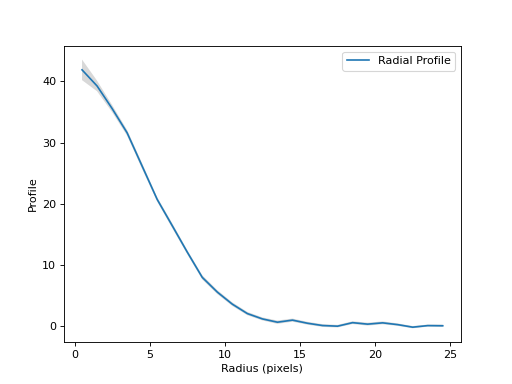
The apertures attribute contains a
list of the apertures. Let’s plot two of the annulus apertures for the
RadialProfile instance on the data:
(Source code, png, hires.png, pdf, svg)
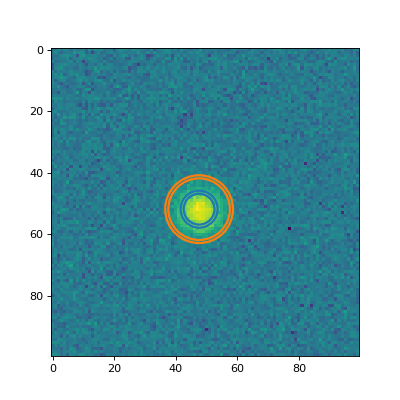
Now let’s fit a 1D Gaussian to the radial
profile and return the Gaussian model using the
gaussian_fit attribute:
>>> rp.gaussian_fit
<Gaussian1D(amplitude=41.54880743, mean=0., stddev=4.71059406)>
The FWHM of the fitted 1D Gaussian model is stored in the
gaussian_fwhm attribute:
>>> print(rp.gaussian_fwhm)
11.09260130738712
Finally, let’s plot the fitted 1D Gaussian model for the
class:RadialProfile radial profile:
(Source code, png, hires.png, pdf, svg)
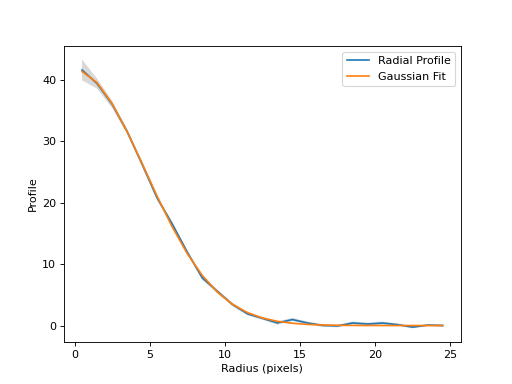
Creating a Curve of Growth¶
Now let’s create a curve of growth using the
CurveOfGrowth class. We use the simulated image
defined above and the same source centroid.
The curve of growth will be centered at our centroid position. It will
be computed over the radial range given by the input radii array:
>>> from photutils.profiles import CurveOfGrowth
>>> radii = np.arange(1, 26)
>>> cog = CurveOfGrowth(data, xycen, radii, error=error, mask=None)
The CurveOfGrowth instance
has radius,
profile, and
profile_error attributes which
contain 1D ndarray objects:
>>> print(cog.radius)
[ 1 2 3 4 5 6 7 8 9 10 11 12 13 14 15 16 17 18 19 20 21 22 23 24
25]
>>> print(cog.profile)
[ 130.57472018 501.34744442 1066.59182074 1760.50163608 2502.13955554
3218.50667597 3892.81448231 4455.36403436 4869.66609313 5201.99745378
5429.02043984 5567.28370644 5659.24831854 5695.06577065 5783.46217755
5824.01080702 5825.59003768 5818.22316662 5866.52307412 5896.96917375
5948.92254787 5968.30540534 5931.15611704 5941.94457249 5942.06535486]
>>> print(cog.profile_error)
[ 5.32777186 9.37111012 13.41750992 16.62928904 21.7350922
25.39862532 30.3867526 34.11478867 39.28263973 43.96047829
48.11931395 52.00967328 55.7471834 60.48824739 64.81392778
68.71042311 72.71899201 76.54959872 81.33806741 85.98568713
91.34841248 95.5173253 99.22190499 102.51980185 106.83601366]
If desired, the curve of growth profile can be normalized using the
normalize() method.
There are also convenience methods to plot the curve of growth and its error:
>>> rp.plot()
>>> rp.plot_error()
(Source code, png, hires.png, pdf, svg)
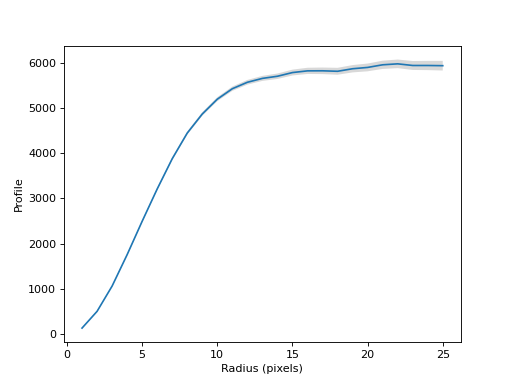
The apertures attribute contains a
list of the apertures. Let’s plot a couple of the apertures on the data:
(Source code, png, hires.png, pdf, svg)
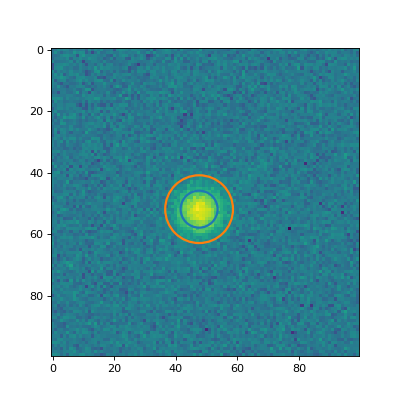
Reference/API¶
This subpackage contains tools for generating radial profiles.
Classes¶
|
Class to create a curve of growth using concentric circular apertures. |
|
Abstract base class for profile classes. |
|
Class to create a radial profile using concentric circular apertures. |